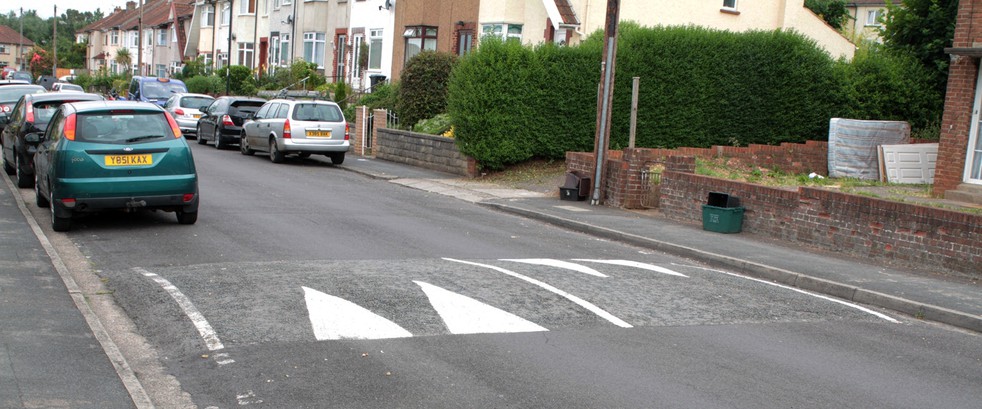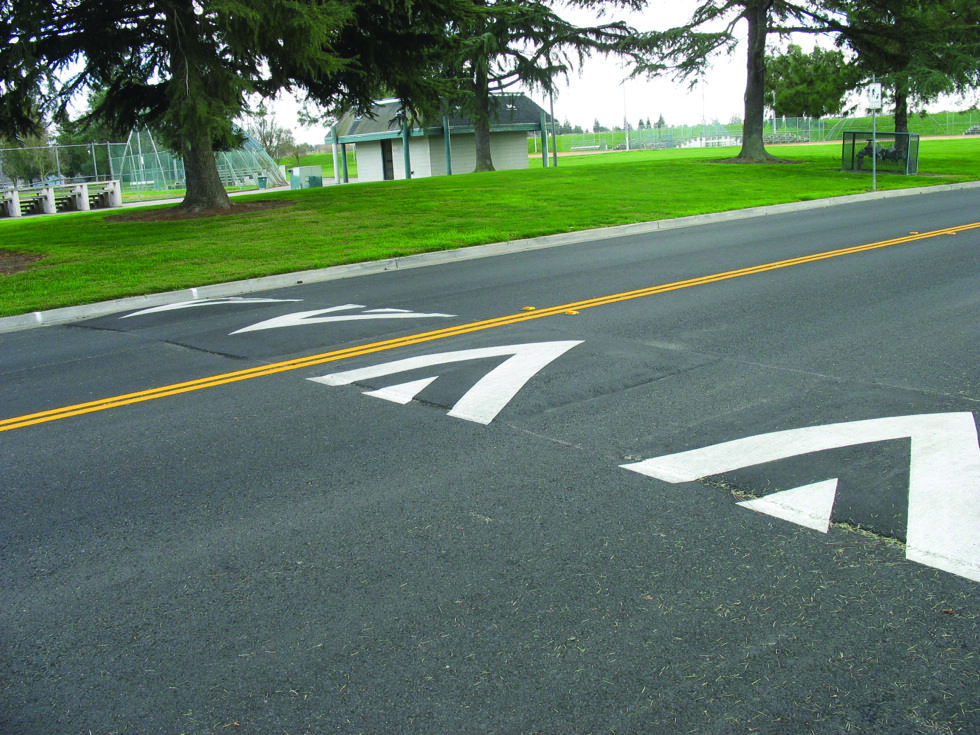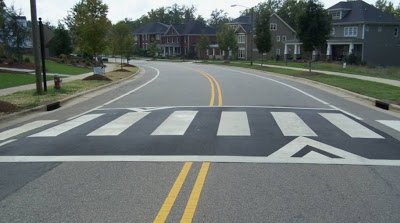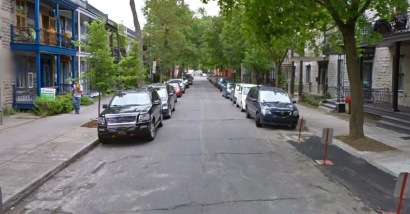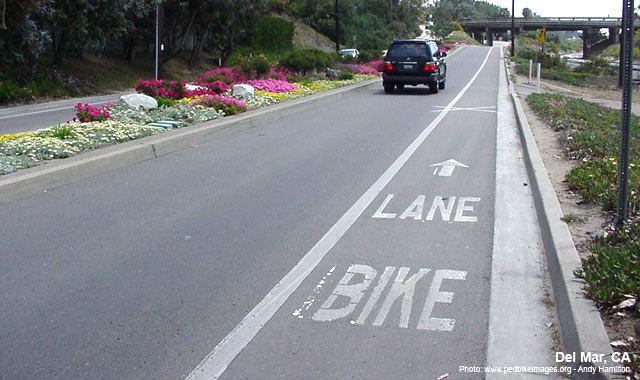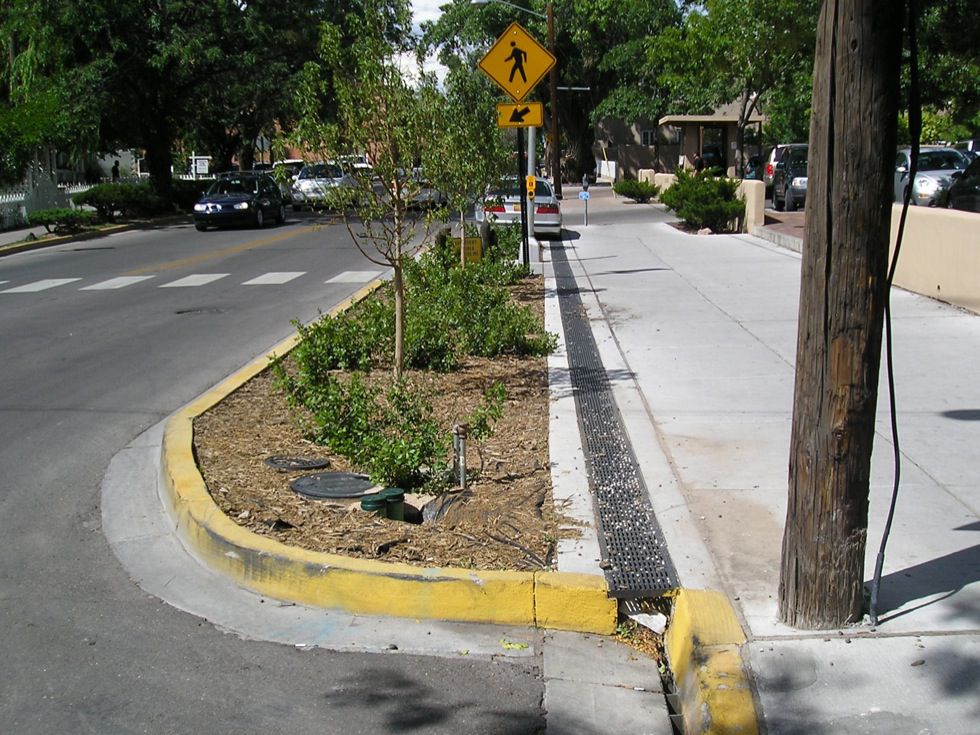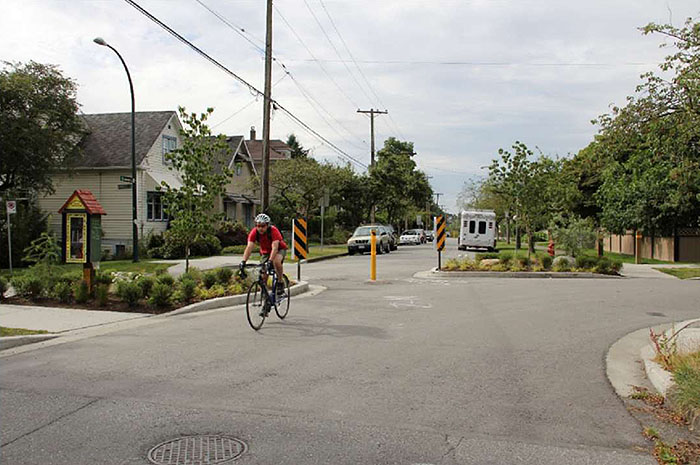Early last week, councillor Druh Farrell put forward a motion to reduce Calgary residential speed limits to 30 km/h. We would argue that this is against all good urban practices, and goes against flow optimization strategies. We understand that some residents get speeders down their roads trying to avoid congested mainline roads, but ultimately, lowering the speed limit won’t help. Calgary Police have a hard time enforcing speed limits on other roads in the city, and making all residential roads 30 km/h will only serve to further tax their traffic division away from other road safety concerns.
We think the solution, as dictated by urban practice elsewhere, is to put in self-enforcement. Read on to see what we mean.
What is self-enforcement?
Self-enforcement is the construction of infrastructure or road-narrowing measures designed to reduce the speed of traffic. These already exist in many newer communities, like Signal Hill, which employs speed humps and raised crosswalks to limit the speed of traffic. They help to reduce the speed of motor vehicles on the road while also encouraging drivers to use main roads over neighbourhood sidestreets. These can come in several forms:
Speedbumps:
Speedbumps are similar to what you might find in a mall parking lot, and function similarly. They slow down all traffic going through the area via the road, including cars, buses, cyclists, and emergency vehicles.
Speed Cushions:
Speed cushions are similar to speedbumps in that they slow most car traffic. However, they are unique in that they have gaps between them. These can be modified in size and height depending on the municipality, but by having gaps between them, they allow larger vehicles and cyclists to travel through without losing speed. Trucks, buses, ambulances, and firetrucks typically need to slow down more than a car for a speed control measure due to their size. These allow these types of vehicles to maintain speed. These speed control devices are already in place in many Calgary neighbourhoods.
Speed tables:
Speed tables are an option similar to speed bumps, but are flat on the top and are typically located at pedestrian/cycling crosswalks. We will discuss these next week when we look at Calgary’s multi-use pathway system. These function similarly to a speedbump, but are unique in that they allow pedestrians and cyclists to maintain their level when crossing the street, improving their speed. They also force vehicles to slow at crosswalks, making them more cognizant of their presence. Unfortunately, similar to speedbumps, these measures slow down all vehicles, including emergency vehicles. They also carry a higher cost due to their size and drainage requirements. For Calgary, these may be a more attractive option than speed cushions due to the ability for snowplows to access the flat area of the device without missing large areas.
The majority of pedestrian collisions occur at crosswalks, and implementing these devices should reduce the likelihood of collision by slowing traffic approaching a crosswalk.
Street design
Beyond the urban furniture that can be added to a road, there are other, relatively costlier methods of reducing speeds in residential areas.
Curb extensions
Curb extensions are a very popular method of reducing speeds, particularly in Calgary. They are advantageous as they narrow the road for vehicles while reducing the amount of road to cross for pedestrians. Like speed tables, these are typically implemented at the location of a crosswalk. They also allow for a clear field of view, by preventing the parking of cars within a certain distance of the crosswalk. We are personally not a fan of these because they seem to waste space. We think other measures are more useful.
Chicane
Chicanes are not particularly well used in Calgary, likely because of the problems they pose to snowplows. However, these are definitely a measure which restricts the speed of through-traffic while creating an area of open vision. Now, we just mentioned our dislike of curb extensions for wasted space. These are similar. In fact, they are a lot like large curb extensions. However, these, unlike curb extensions, can be created by strategically locating car parking zones, for example, or by locating bike racks in these areas. For curb extensions, these methods do not work because curb extensions are typically located at crosswalks. Chicanes are typically placed mid-block.
Pinchpoints
Pinchpoints can come in many forms.
Parked cars are a no-cost method of reducing road width. However, they also reduce visibility approaching intersections and pedestrian crosswalks, and can be parked haphazardly, as we all know.

Bike lanes are also an effective road-narrowing option of increased cost. Pictured here are “fietstrook” lanes used in the Netherlands, which encourage cyclist priority while narrowing roads, and are best used in areas with high volumes of cyclists, or in conjunction with other speed measures, like speed cushions. On the right are typical painted bike lanes which demarcate an area of the road dedicated to cyclists. There are advantages and disadvantages to bike lanes. One of the obvious advantages is increasing the mobility of cyclists while reducing vehicle speeds. Disadvantages are the possibility they may not reduce speeds, depending on the usage of the lane. Alternatively however, temporary or permanent measures such as bollards or “road armadillos” can serve to reinforce narrow lanes by putting objects that vehicles really do not want to hit on the roadside.
Road extensions like these are also an option, and are similar to curb extensions. Again, they can be wasted space, a location for community gardens/greenery, as seen above, or can contain bike racks or bus benches.
Intersections
Residential intersections at major roads can be very hazardous for the pedestrian. We believe there are a couple of solutions to solving this problem.
One option is the four-way stop. It is low-cost, easy to implement, and relatively effective. However, these measures can also serve to create unnecessary congestion and peak times (which could be good or bad, depending on whether you want that traffic), and still permit uncaring motorists to go straight through. They are also unfriendly to cyclists which tend to use residential sidestreets.
Another option are small roundabouts, which force traffic to slow approaching the intersection while maintaining free-flow conditions. These devices are also very cyclist friendly in terms of speed. They must have good approaches however, for drivers and cyclists to view oncoming traffic. They are already employed in many areas of Calgary already.
Finally, diverters can be used in specific areas where the flow of through-traffic is to be completely discouraged. These traffic filters can also have the effect of promoting cycling and walking. These modes will have shorter travel distances while cars must find a route around the intersection. These diverters can also act as the entryways to green streets, or streets where vehicles are completely prohibited. These may be desired in certain areas where alleyways provide effective road access to homes.
Safety
Proponents of lower speed limits like to put safety of pedestrians as a primary argument for why we should accept 30 km/h limits. Though we have no choice to agree that fatalities occur at higher speeds, we aim to prevent the collision from occurring in the first place. On residential roads, pedestrian-vehicle collision rarely result in fatalities. Far more common however, are injuries of varying severity. As we previously mentioned, injuries are far more likely to occur at intersections. The treatments we proposed above are all designed to slow the approaches to intersections, while also reducing overall vehicle speed. We think the NACTO diagram below is very helpful at explaining why this is the case.
Though we don’t necessarily agree with the message of limiting residential speeds, we can see there is certainly some merit in having speed reduction measures in place approaching critical junctions.
To conclude…
All of these measures have varying costs attached to them, and can be implemented at varying costs, from a couple hundred for easily purchasable temporary speed humps, up to several million for a long, protected bikeway. What must also be considered to some degree is the ability for snowplows to clear the surrounding area. Certain treatments may only work on major roads where traffic volume can clear snow in the gaps snowplows cannot reach. Other treatments going in low-traffic areas may not matter as much due to the length of time before a snowplows will access the area after major snowfall.
We think in the big picture however, these measures will be far more effective than simply mandating a lower speed limit which will invariably be followed, and will be difficult to enforce. These treatments give drivers no choice but to slow down, and help encourage other active transportation modes. Perhaps on streets where volumes of speeders are high, fine revenue can be collected until enough is accumulated to install a temporary speed treatment.

